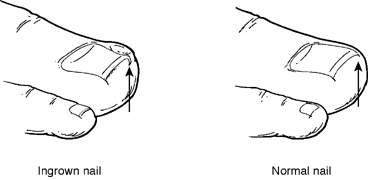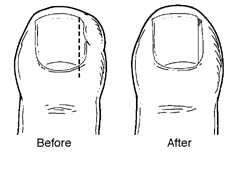
Ingrown Toenail (Onychocryptosis)
What is an Ingrown Toenail?
When a toenail is ingrown, the nail is curved downward and grows into the skin, usually at the nail borders (the sides of the nail). This “digging in” of the nail irritates the skin, often creating pain, redness, swelling, and warmth in the toe.
If an ingrown nail causes a break in the skin, bacteria may enter and cause an infection in the area, which is often marked by drainage and a foul odour. However, even if your toe isn’t painful, red, swollen, or warm, a nail that curves downward into the skin can progress to an infection.
What is an Ingrown Toenail?
When a toenail is ingrown, the nail is curved downward and grows into the skin, usually at the nail borders (the sides of the nail). This “digging in” of the nail irritates the skin, often creating pain, redness, swelling, and warmth in the toe.
If an ingrown nail causes a break in the skin, bacteria may enter and cause an infection in the area, which is often marked by drainage and a foul odour. However, even if your toe isn’t painful, red, swollen, or warm, a nail that curves downward into the skin can progress to an infection.
What Causes an Ingrown Toenail?
Ingrown toenails can develop for various reasons. In many people, the tendency to have this common disorder is inherited. In other cases, an ingrown toenail is the result of trauma, such as stubbing your toe, having an object fall on your toe, or engaging in activities that involve repeated pressure on the toes, such as kicking or running.
The most common cause of ingrown toenails is improper trimming. Cutting your nails too short encourages the skin next to the nail to fold over the nail. Another cause of ingrown toenails is wearing shoes that are tight or short.
Certain nail conditions are often associated with ingrown toenails. For example, if you have had a toenail fungal infection or if you have lost a nail through trauma, you are at greater risk for developing an ingrown toenail.
Treatment
Ingrown toenails can develop for various reasons. In many people, the tendency to have this common disorder is inherited. In other cases, an ingrown toenail is the result of trauma, such as stubbing your toe, having an object fall on your toe, or engaging in activities that involve repeated pressure on the toes, such as kicking or running.
The most common cause of ingrown toenails is improper trimming. Cutting your nails too short encourages the skin next to the nail to fold over the nail. Another cause of ingrown toenails is wearing shoes that are tight or short.
Certain nail conditions are often associated with ingrown toenails. For example, if you have had a toenail fungal infection or if you have lost a nail through trauma, you are at greater risk for developing an ingrown toenail.
Treatment
Sometimes initial treatment for ingrown toenails can be safely performed at home. However, home treatment is strongly discouraged if you suspect you have an infection, or if you have a medical condition that puts your feet at high risk—for example, diabetes, nerve damage in the foot, or poor circulation.
Home care:
If you don’t have an infection or any of the above conditions, you can soak your foot in room-temperature water (add Epsom’s salt if you wish), and gently massage the side of the nail fold to help ease the tissue away from the nail and reduce the inflammation.
Avoid attempting “bathroom surgery.” Repeated cutting of the nail can cause the condition to worsen over time. If your symptoms fail to improve, it’s time to see a podiatrist.
Podiatric Care:
The toe will be examined and you will be advised of the most appropriate treatment.
Treatment may include:
Home care:
If you don’t have an infection or any of the above conditions, you can soak your foot in room-temperature water (add Epsom’s salt if you wish), and gently massage the side of the nail fold to help ease the tissue away from the nail and reduce the inflammation.
Avoid attempting “bathroom surgery.” Repeated cutting of the nail can cause the condition to worsen over time. If your symptoms fail to improve, it’s time to see a podiatrist.
Podiatric Care:
The toe will be examined and you will be advised of the most appropriate treatment.
Treatment may include:
- Oral antibiotics. If an infection is present, an oral antibiotic may be prescribed.
- Removal of nail spike. Often done under local anaesthetic this simple procedure is temporarily helpful to ease symptoms, although a more definitive procedure is usually advised to permanently treat the problem.
- Permanent removal of part or all of the nail. Various techniques may be used to destroy or remove the nail root. This treatment prevents the recurrence of an ingrown toenail. Your will advised of the most appropriate procedure for you.
Following nail surgery, a light bandage will be applied. Most people experience very little pain after surgery and may resume normal activity the next day. If you have been prescribed an oral antibiotic, be sure to take all the medication, even if your symptoms have improved.
Preventing Ingrown Toenails
Many cases of ingrown toenails may be prevented by following these two important tips:
Preventing Ingrown Toenails
Many cases of ingrown toenails may be prevented by following these two important tips:
- Trim your nails properly. Cut your toenails in a fairly straight line, and don’t cut them too short. You should be able to get your fingernail under the sides and end of the nail.
- Avoid poorly-fitting shoes. Don’t wear shoes that are short or tight in the toe box. Also avoid shoes that are loose, because they too cause pressure on the toes, especially when you run or walk briskly.
The Truths about Home Treatment
Myth: Cutting a notch (a “V”) in the nail will reduce the tendency for the nail to curve downward.
Truth: Cutting a “V” does not affect the growth of the toenail. New nail growth will continue to curve downward.
Myth: Repeated trimming of the nail borders is a good way to treat ingrown toenails.
Truth: Repeated nail trimming fails to correct future nail growth and can make the condition worse.
Myth: Cotton wool placed under the nail will relieve the pain.
Truth: Cotton placed under the nail can be harmful. It can easily harbour bacteria and encourage infection.
Myth: You can buy effective ingrown toenail treatments at the chemist.
Truth: Over-the-counter topical medications may mask the pain, but they fail to address the underlying problem.
Myth: Cutting a notch (a “V”) in the nail will reduce the tendency for the nail to curve downward.
Truth: Cutting a “V” does not affect the growth of the toenail. New nail growth will continue to curve downward.
Myth: Repeated trimming of the nail borders is a good way to treat ingrown toenails.
Truth: Repeated nail trimming fails to correct future nail growth and can make the condition worse.
Myth: Cotton wool placed under the nail will relieve the pain.
Truth: Cotton placed under the nail can be harmful. It can easily harbour bacteria and encourage infection.
Myth: You can buy effective ingrown toenail treatments at the chemist.
Truth: Over-the-counter topical medications may mask the pain, but they fail to address the underlying problem.


